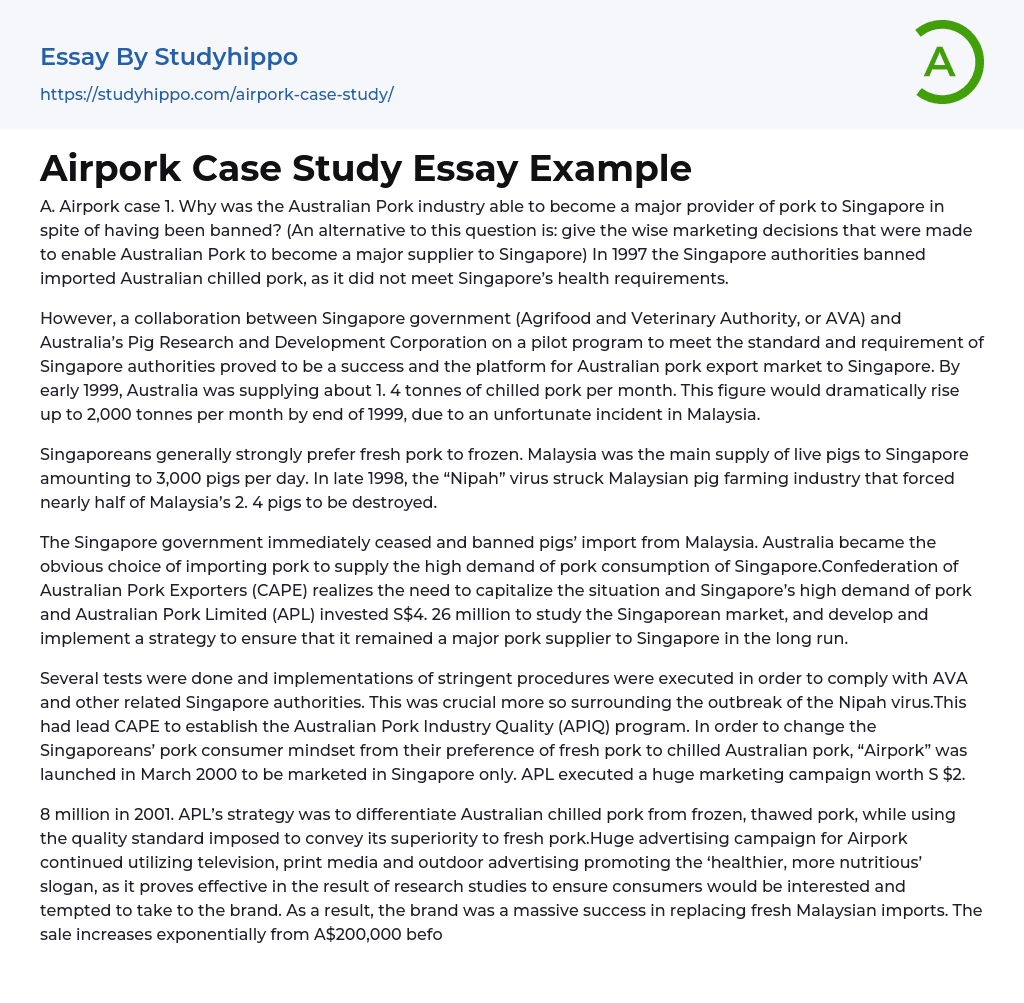A. Airpork case 1. Why was the Australian Pork industry able to become a major provider of pork to Singapore in spite of having been banned? (An alternative to this question is: give the wise marketing decisions that were made to enable Australian Pork to become a major supplier to Singapore) In 1997 the Singapore authorities banned imported Australian chilled pork, as it did not meet Singapore’s health requirements.
However, a collaboration between Singapore government (Agrifood and Veterinary Authority, or AVA) and Australia’s Pig Research and Development Corporation on a pilot program to meet the standard and requirement of Singapore authorities proved to be a success and the platform for Australian pork export market to Singapore. By early 1999, Australia was supplying about 1. 4 tonnes of chilled pork per month. This figure would dramatically rise up to 2,000 t
...onnes per month by end of 1999, due to an unfortunate incident in Malaysia.
Singaporeans generally strongly prefer fresh pork to frozen. Malaysia was the main supply of live pigs to Singapore amounting to 3,000 pigs per day. In late 1998, the “Nipah” virus struck Malaysian pig farming industry that forced nearly half of Malaysia’s 2. 4 pigs to be destroyed.
The Singapore government immediately ceased and banned pigs’ import from Malaysia. Australia became the obvious choice of importing pork to supply the high demand of pork consumption of Singapore.Confederation of Australian Pork Exporters (CAPE) realizes the need to capitalize the situation and Singapore’s high demand of pork and Australian Pork Limited (APL) invested S$4. 26 million to study the Singaporean market, and develop and implement a strategy to ensure that it remained a major pork supplier to
Singapore in the long run.
Several tests were done and implementations of stringent procedures were executed in order to comply with AVA and other related Singapore authorities. This was crucial more so surrounding the outbreak of the Nipah virus.This had lead CAPE to establish the Australian Pork Industry Quality (APIQ) program. In order to change the Singaporeans’ pork consumer mindset from their preference of fresh pork to chilled Australian pork, “Airpork” was launched in March 2000 to be marketed in Singapore only. APL executed a huge marketing campaign worth S $2.
8 million in 2001. APL’s strategy was to differentiate Australian chilled pork from frozen, thawed pork, while using the quality standard imposed to convey its superiority to fresh pork.Huge advertising campaign for Airpork continued utilizing television, print media and outdoor advertising promoting the ‘healthier, more nutritious’ slogan, as it proves effective in the result of research studies to ensure consumers would be interested and tempted to take to the brand. As a result, the brand was a massive success in replacing fresh Malaysian imports. The sale increases exponentially from A$200,000 before the Nipah virus to A$113 million in 2001. Aipork commanded 95% of the chilled market in Singapore.
Therefore three main factors played its part in enabling Australian pork to become a major supplier to Singapore; 1.The pilot program between Singapore government (Agrifood and Veterinary Authority, or AVA) and Australia’s Pig Research and Development Corporation to meet the standard and requirement of Singapore authorities, 2. The unfortunate Nipah virus that crippled Malaysian fresh pigs import to Singapore, and 3. The successful marketing and advertising campaign to change the mindset of Singaporeans consumers to accept
the Airpork brand.
2. Given the initial success of the Airpork project, what further could the Australian pork industry do to further increase the sales of its pork in Singapore and elsewhere?The Australian pork industry needs to continue it marketing and advertising campaigns especially to capitalize on the growing preference for supermarket-packed meat among the younger consumers. The branding of Airpork needs to continue to stay fresh and project the ‘healthier, more hygienic’ image. The quality management in the handling of the meat must also be met and continued to be develop for a better process that would meet stringent requirements of the Singapore and elsewhere. Several processes such as; 1.A more effective time-management on at both airports in Australia and Singapore for a better-controlled container temperatures, 2.
Better facilities and adequate infrastructures in Singapore, and 3. Faster implementation of AQIS health certificates and clearance for transshipment and distribution. The Australian pork industry also need to start deflecting the growing interest on the US and Canadian pork in the local market. A strategy is needed to allay the perception the consumers thinking North American meat as being of higher quality as it commands premium prices.
- Wal-Mart essays
- Discover essays
- Food Safety essays
- Food Security essays
- Beverages essays
- Cuisines essays
- Dairy essays
- Desserts essays
- Fast Food essays
- Bread essays
- Meal essays
- Meat essays
- Organic Food essays
- Rice essays
- Sugar essays
- Taste essays
- Beef essays
- Coconut essays
- Crowd essays
- Dinner essays
- Juice essays
- Sainsbury essays
- Cooking essays
- Ginger essays
- Oreo essays
- Drink essays
- Beer essays
- Wine essays
- Coffee essays
- Tea essays
- Cake essays
- Hamburger essays
- Ice Cream essays
- Burger essays
- Pizza essays
- Fruit essays
- Lemon essays
- Food Waste essays
- Favorite Food essays
- Alcoholic essays
- Soft Drinks essays
- Cookie essays
- Starch essays
- Yeast essays
- Cola essays
- Pizza Hut essays
- snack foods essays
- chips essays
- Biscuit essays
- Brewing essays




